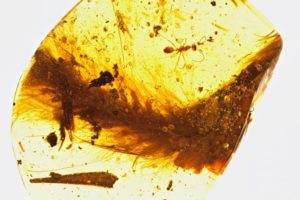 MYANMAR – Evolutionists are heralding the discovery of a well-preserved feathered tail in Asia as evidence that dinosaurs once had plumage, while creationists maintain that the specimen likely came from a bird.
MYANMAR – Evolutionists are heralding the discovery of a well-preserved feathered tail in Asia as evidence that dinosaurs once had plumage, while creationists maintain that the specimen likely came from a bird.
Last week, a team of researchers consisting primarily of scientists from Canada and China published a journal article in “Current Biology.” The article, titled “A Feathered Dinosaur Tail with Primitive Plumage Trapped in Mid-Cretaceous Amber,” describes a piece of amber, approximately the size of an apricot, that was found at an amber market in Myanmar.
Several objects are encased in the amber, including ants, beetles, and plant fragments. But the most prominent and interesting object in the amber is a feathered tail measuring 1.45 inches in length. The journal article’s authors believe the tail belonged to a baby dinosaur that got stuck in tree resin nearly 100 million years ago and never escaped.
“Here we describe the feathered tail of a non-avialan theropod preserved in mid-Cretaceous (~99 Ma) amber from Kachin State, Myanmar, with plumage structure that directly informs the evolutionary developmental pathway of feathers,” the scientists wrote. “This specimen provides an opportunity to document pristine feathers in direct association with a putative juvenile coelurosaur, preserving fine morphological details, including the spatial arrangement of follicles and feathers on the body, and micrometer-scale features of the plumage.”
The scientists described the preserved tail as an “astonishing” specimen that highlights “the unique preservation potential of amber.”
“The tail … is visible to the naked eye as an elongate and gently curved structure (length = 36.73 mm),” the researchers observed. “A dense covering of feathers protrudes from the tail. … Soft tissues—presumably muscles, ligaments, and skin—are visible sporadically through the plumage.”
Ryan McKellar, one of the journal article’s co-authors, said the apricot-sized piece of amber, known as DIP-V-15103, is “a once in a lifetime find” that may change the way people think of dinosaurs.
“The more we see these feathered dinosaurs and how widespread the feathers are, things like a scaly velociraptor seem less and less likely and they’ve become a lot more bird like in the overall view,” he told reporters. “They’re not quite the Godzilla-style scaly monsters we once thought.”
“It really underlines the importance of amber as an anchor for future study,” he added. “We’re picking up features we couldn’t see in compressed sedimentary fossils.”
Although the scientists acknowledged that “the preserved segment is only a small mid to distal portion of what was likely a relatively long tail,” they are confident that the tail came from a feathered dinosaur—specifically, a non-avialan theropod. They also say the discovery sheds light on the evolution of feathers.
However, other scientists have expressed skepticism over DIP-V-15103. Frank Sherwin, writing for the Institute for Creation Research, said the scientific community’s celebration over the specimen is “premature” and dismissed the discovery as “another feathered dinosaur tale.” Similarly, Dr. David Menton with Answers in Genesis said the feathers likely came from a bird—not a baby dinosaur.
“It is obviously not very exciting for an evolutionist to report unambiguous feathers on an avian dinosaur such as a robin,” Menton wrote in an online article published on Monday, “but it is career making, with the help of National Geographic, for an evolutionist to claim that such feathers occur in a non-avian dinosaur like a theropod dinosaur.”
“We conclude that DIP-V-15103 is a bird, and not a 99-million-year-old theropod dinosaur,” Menton wrote.
Become a Christian News Network Supporter...


